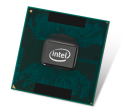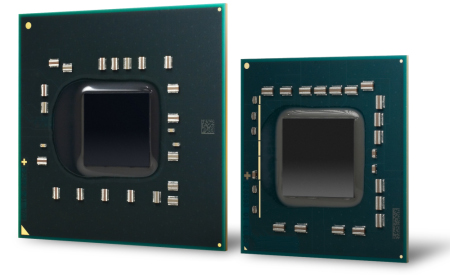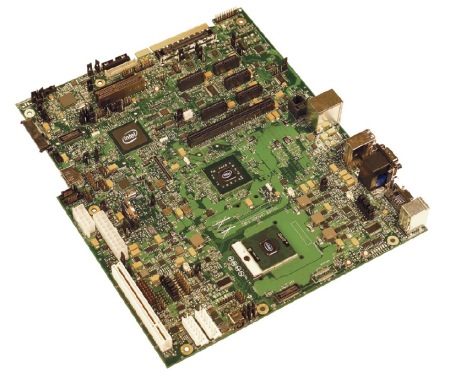Intel aims T9400, GM45 at device market
Jul 16, 2008 — by LinuxDevices Staff — from the LinuxDevices Archive — 11 views This week, Intel launched five 45nm Core 2 Duo processors under its new “Centrino 2” moniker. The overall announcement emphasized laptops, but the company's new 2.53GHz T9400 processor and GM45 Express chipset target embedded devices, with a touted seven-year lifecycle and available EMBC2DGM45DRxDK dev board.
This week, Intel launched five 45nm Core 2 Duo processors under its new “Centrino 2” moniker. The overall announcement emphasized laptops, but the company's new 2.53GHz T9400 processor and GM45 Express chipset target embedded devices, with a touted seven-year lifecycle and available EMBC2DGM45DRxDK dev board.
(Click here for a larger view of Intel's Core 2 Duo T9400)
The five new Core 2 Duo processors — previously code-named “Penryn,” while the overall Centrino 2 CPU/chipset platform has been code-named “Montevina” — are summarized in the chart below. Manufactured using the company's 45nm process, they offer 3MB or 6MB of second-level cache, and a 1066MHz FSB (front side bus), compared to the 800MHz FSB of the company's previous mobile chips. In addition to support for power-saving DDR3 memory, Intel touts “Dynamic Acceleration” and “Deep Power Down,” which allows components such as the core clocks and cache memory to shut down when they're not needed.
| Processor Number | GHz | FSB | Cache | TDP | Pricing (1000 units) |
| T9600 | 2.80 | 1066 | 6MB | 35W | $530 |
| T9400 | 2.53 | 1066 | 6MB | 35W | $316 |
| P9500 | 2.53 | 1066 | 6MB | 25W | $348 |
| P8600 | 2.40 | 1066 | 3MB | 25W | $241 |
| P8400 | 2.26 | 1066 | 3MB | 25W | $209 |
Intel's Core 2 Duo T9400 is the “embedded” sibling in a family of five
T9400
Of the five, it's the T9400 that will be of particular interest to embedded developers. Not only did Intel promise a seven-year extended lifecycle for the CPU, Intel unveiled a new GM45 Express chipset intended specifically to support the T9400. Together, the parts “enable embedded applications that demand rich graphics and vivid video playback, such as gaming, point-of-sale, and in-store media networks for retailers,” Intel says.
As company documents confirm, the T9400 pays tribute to the increased performance many embedded applications now require. At 2.53GHz, it scores an estimated 135 points on the SYSmark 2007 processor benchmark. In contrast, the previous-generation, entry-level Core 2 Duo T7100 scored 95, Intel says.
The T9400 uses a “Hafnium-infused high-k formula” that “increases processor performance by doubling transistor density,” according to Intel. As mentioned earlier, it features a 6MB second-level cache and 1066MHz frontside bus.

Intel's GM45 Express chipset
(Click to enlarge)
GM45
The GM45 Express chipset (above) consists of the GM45 GMCH (graphics memory controller hub) and ICH (I/O controller hub) 9M. Benefits of the chipset — which, like the T9400, is offered with a seven-year lifecycle — include, according to Intel:
- Optimization specifically for the T9400
- Dual-channel memory controller, supporting non-ECC, 667/800MHz DDR2 RAM, or 800/1066MHz SO-DIMM SDRAM
- Graphics Media Accelerator 4500MHD, with graphics core speeds up to 533MHz, and support for high-definition video playback
- Support for display/video output options such as VGA, LVDS, DVI, HDMI, and DisplayPort
- Graphics drivers and video BIOS developed specifically for embedded products and applications
GM45 Express Chipset dev board
While a bevy of products based on the T9400 and GM45 Express chipset appears to be imminent, Intel also primed the pump by releasing its own development kit, the expansively named “Intel Core 2 Duo Processor T9400 and Mobile Intel GM45 Express Chipset Development Kit” (shown below). The kit, whose dimensions were not cited, is available with a choice of two boards:
- The EMBC2DGM45DR2DK has two slots supporting DDR2 SoDIMMs
- The EMBC2DGM45DR3DK has two slots supporting DDR3 SoDIMMs

The “Intel Core 2 Duo Processor T9400 and Mobile Intel GM45 Express Chipset Development Kit”
(Click to enlarge)
The board appears to relegate the SoDIMM slots to the back, and to offer surface-mount expansion, possibly for an available “HDMI and display port extension card” and “PCI extension card” listed in the datasheet. Both kits ship with 512MB of RAM, an 80GB hard drive, and an SATA-interfaced DVD drive.
The development kit provides features that include the following, according to Intel:
- 1 single-channel serial digital video output (SDVO) port on x16 connector
- 1 x16 PCI Express graphics or dual-channel SDVO graphics interface
- Dual-channel 24-bit LVDS interface; BLI and LED backlight support
- VGA port
- HDMI and display port connectors via extension card
- 5 PCI Express x1 connectors
- 12 x USB 2.0 ports
- 1 x gigabit Ethernet, with RJ45 connector
- 1 x IrDA port
- 1 x PS/2 port for keyboard and mouse
- Scan matrix keyboard header
- XDP debug port
- High-definition audio MDC header
- PCI support via extension card
- LPC connector
According to Intel, the development kit is compatible with Red Hat, Red Flag, and SuSE Linux, as well as VxWorks and the following Windows versions: XP SP2, XP Embedded SP2, Vista, Embedded for Point of Sale (WEPOS), and CE 6.0.
Availability
While pricing for the development kit was not released, the T9400 costs $316 in quantities of 1,000, while the GM45 Express chipset costs $43. All products appear to be shipping now.
For further information on Intel's new laptop-oriented Core 2 Duo processors, see the coverage on our sister site eWEEK.com, here.
This article was originally published on LinuxDevices.com and has been donated to the open source community by QuinStreet Inc. Please visit LinuxToday.com for up-to-date news and articles about Linux and open source.